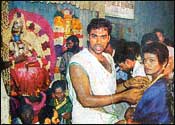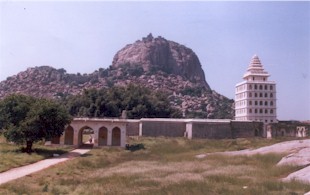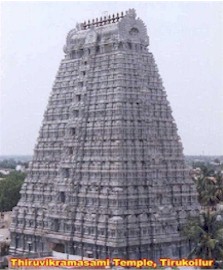 Viluppuram
Viluppuram (also Villupuram) is one of thirty districts which make up
Tamil Nadu State situated on the southern tip of
India. Viluppuram District came into existence on
30 September 1993 when it was created out of
South Arcot District.
The district headquarters are located at
Viluppuram. The district occupies an
area of 7217
km² and has a
population of 2,960,373 (as of
2001).
This district is listed as the second-most backward district in Tamil Nadu. It is only 14.42% urbanised as per Census 2001
Early history From the 1st to the 4th centuries CE the
Chola were the rulers of the area,
Karikala Chola was the most famous and powerful individual of the time. The grip of Chola rule was broken when the Cholas were overthrown by Simha Vishnu Pallava and the region came under the
Pallava rule. Vijayalaya Chola again revived Chola rule. This was the beginning of great Chola Empire. The later Chola rulers were weak and the power passed on to the hands of
Eastern Chalukyas.Cholas regained their lost position but with the rise of Jatavarman Sundara Pandya-1 (1251), Chola supremacy came to an end. The sway of
Pandyas lasted for over 50 years, followed by Muslim domination from
1334 to
1378 By 1378, the region came under the rule of
Vijayanagar Kingdom and
Nayaks were appointed as the rulers of the region.In
1677 Shivaji took the Ginjee area with the assistance of
Golkonda forces. Then came the
Mughals. During the Mughal regime, both the
English and
French acquired settlements in South Arcot. During the Anglo-French rivalry, the entire district was turned into a battleground. After sometime, the entire area came under the control of
British East India Company. It remained under British authority till
1947 when India became independent.
Geographical location Viluppuram is the second largest district in the state. It is connected to the national road network by Chennai National Highway No. 45. It is also well connected to the rest of the state and country by rail and is the site of a major junction. The region has a variety of historical tourist attractions many of which are more than 100 years old. The district has temples, mosques and churches which are very old and famous.
LOCATION AND AREA
Villupuram Ramaswamy Padaiyatchiar is one of the famous tourist centres in Tamil Nadu due to the historical monuments, edifices, sacred and ancient temples. The fort at Gingee is a rare monument of historic beauty. The district is bounded by the Bay of Bengal in the east, by South-Arcot in the south, by Salem and Dharmapuri districts in the west and by Chengai-Anna and Tiruvannamalai Samburayan districts in the north. Villupuram is the administrative headquarters of this district.
COMMUNICATIONS
The old southern trunk road from Chennai (Madras) to Tiruchchirappalli passes through the towns of Tindivanam, Villupuram and Ulundurpettai. Among the important State Highways is the Ulundurpettai-Attur road passing through Kallakkurichchi taluk. The district is also well connected by rail transport. The metre gauge line of southern railways i.e. between Chennai (Madras) and Dhanushkodi, runs via Tindivanam and Villupuram. The chord line from Villupuram to Tiruchchirappalli runs via Ulundurpettai. A branch line connects Villupuram and Katpadi and another branch line connects Villupuram with Pondicherry.
TOURISM
Gingee (Senji) is the headquarter of the Gingee taluk. It is famous for the historical fort, which stretches about 2 kms. and stands on three hills. The citadel on the north is called Krishnagiri, that on the south Chandrayandurg and that on the west Rajagiri. A weekly fair is held on all Fridays. Malaiyanur is a village in Gingee taluk, thirteen km, north-west of Gingee. Mailam is a village in Tindivanam taluk, 13 km by south of Tindivanam. This place is chiefly known for it's temple of Lord Subramanya. It is believed that the place was named after the peacock which is the Lord's Vahanam vehicle. Sringavaram is a village in Ginjee taluk, 3 km. north of Gingee. There is a shrine of Lord Ranganatha which to supposed to have been the tutelary deity of Raja Desing. tirukkoyilur lies on the bank of the Pondicherry and has a fine view of the Kalrayan and Tenmalai hills on one side, Thiruvannamalai peak and the Ginjee Hills are on different sides. The ancient Vishnu Temple built-up the Pallavas here is dedicated to Trivikarma Perumal. There is also a famous Sina temple here. Tiruvennapallm is village in Tirukkoyilur taluk about 22 km. south- west of Tirukkoyilur. Kambar is stated to have lived in this place. Saint Sundaran is supposed to have married here. The Siva temple this village isedicated to Kripapuriswara. It is a very sacred shrine.
INDUSTRIES The district has fairly rich mineral deposits. The fossilferrous cretaceous limestones are found in Thirunakkanai near Tindivanam. The alluvial beds are found in Vellalar and that of the combined Ponnaiyenr. Gadilam and Ginjee rivers. Iron ore is found to occur in limited quantity along the banks of river Pennar in Kallakkurichi taluk. In Kunnam near Tindivanam, world famous black granie is available in plenty and a greater part of it being exported. Those rocks are capable of taking high polish and are used for wall facings, floor tiles and as monumental stones. In Marakkanam near Tindivanam, Plenty of lime shell deposits all along the coast are found which are of high chemical grade. Besides this, silica sands of high purity, containing 99.9 percent of silicon dioxide occur as natural sands near manakkanam. Sugar industry is also a major industry in the district. Kallakkurichi Co-operative sugar Mills ltd. Located at Moongithuraipattu in Kallakkurichi is one of the major sugar mills in this district. IMPORTANT INDUSTRIES, 1996 South India Sugars Ltd. Mundiampakkam, Distt. Villupuram, Tamil Nadu. Manufacturer: Sugar molasses, bagass and dealing in fertilizer.
AGRICULTURE AND IRRIGATION The principal cereal crops of this district are paddy, varagu, cholam, cumbu, ragi, etc. Important varieties of pulses are red gram, green gram and black gram. Chief commercial crops of the district are groundnut, sugarcane, gingelly etc. Bananas and mangoes are the important fruits cultivated in the district. The principal rivers that serve the region are the Coleroon, vellar manimukthanaeli and Ponnaiyar. All these rivers flows in valleys an have been harnessed for irrigation purposes by anicuts builds across them at various stages of their course. Tanks are also used for irrigation.





